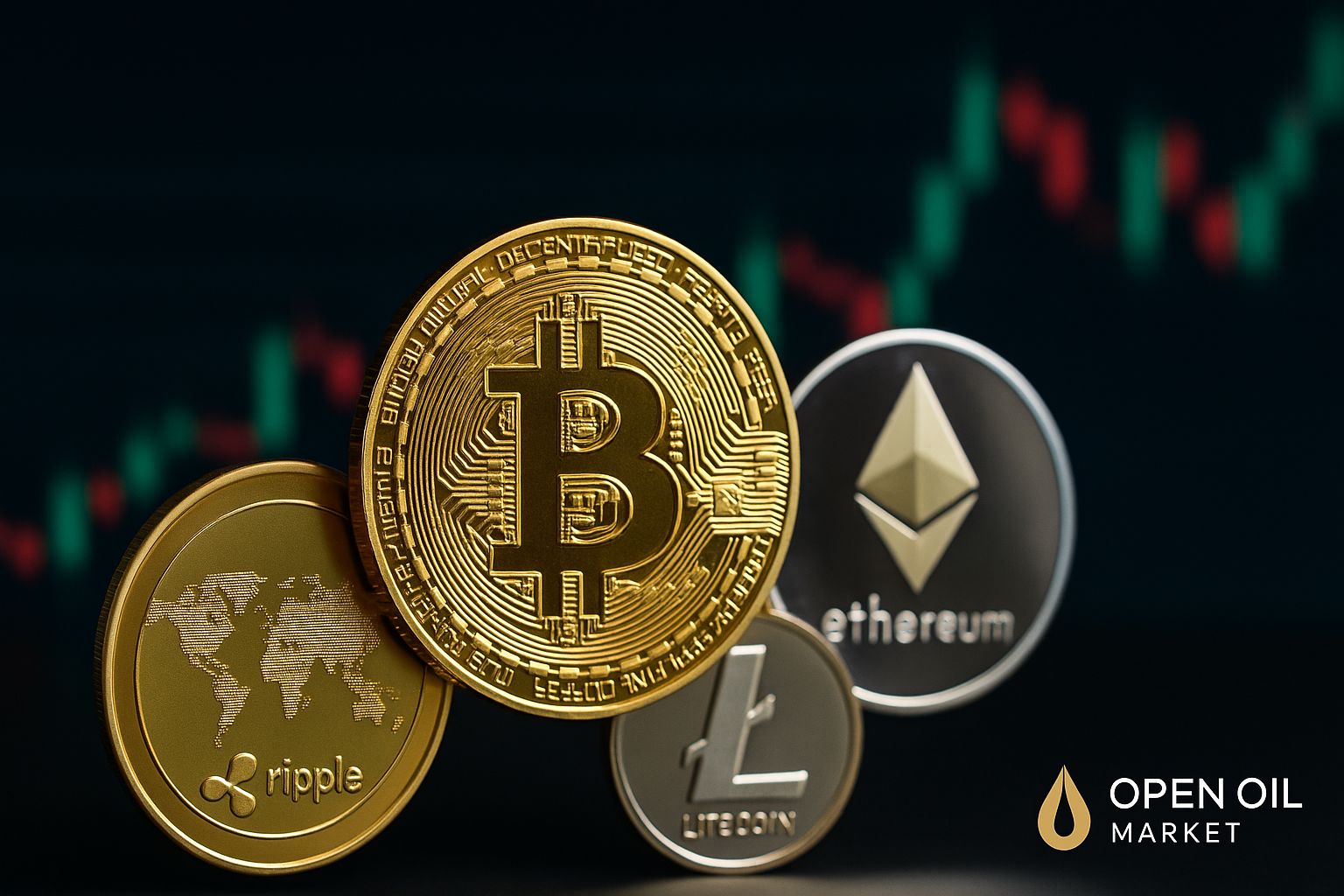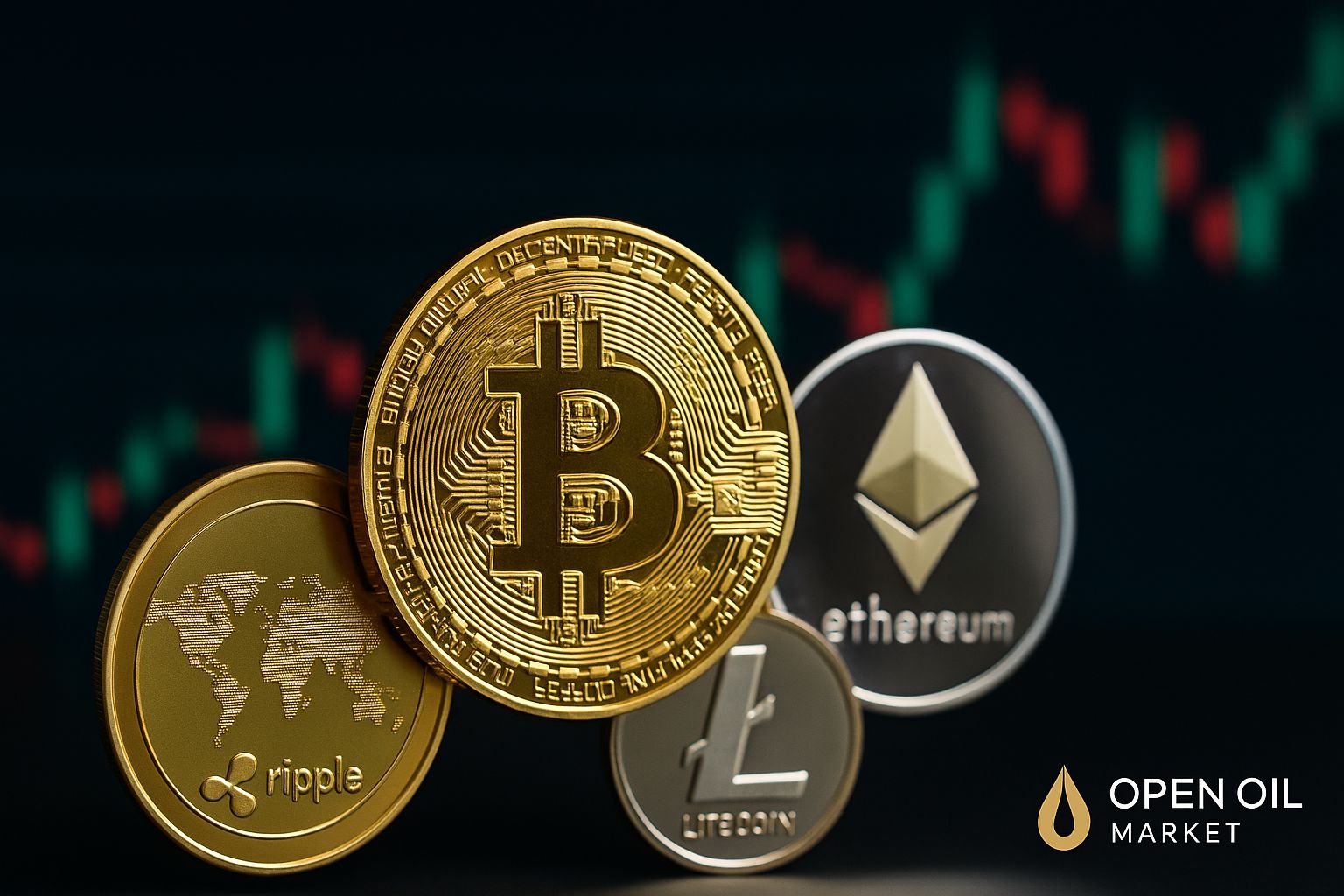
Current Cryptocurrency News as of August 18, 2025: Bitcoin Trading Near Historical Highs, Aiming for $125,000, Ethereum Holding Steady Around Peak Values, Major Altcoins Consolidate, Investors Await Signals from the Fed and New Regulatory Measures in the US, Europe, Asia, and the CIS.
As the new week begins, the cryptocurrency market remains near record levels following a mid-August rally. Bitcoin fluctuated around $120,000 over the weekend, just below its recent historical high of approximately $124,000, as it attempts to gain momentum for a breakthrough towards $125,000. Ethereum is also holding close to multi-year peak values, having reached around $4,800 last week and now consistently trading above $4,600. The total market capitalization of cryptocurrencies continues to exceed $4 trillion, significantly ahead of last year's levels.
Market Overview
Following a rapid rise in mid-August, the global cryptocurrency market has begun to consolidate around record levels. As the week kicks off, Bitcoin remains near $120,000, demonstrating relative stability amid reduced weekend trading volumes. Short-term pullbacks—such as a price decline in the middle of last week—are quickly compensated, and the leading cryptocurrency retains most of its gained positions. Optimism in the market is supported by expectations of an upcoming easing of the US Federal Reserve's monetary policy and positive regulatory steps, maintaining a high level of confidence in digital assets.
Ethereum shows a similar trend: the second-largest crypto asset reached a local peak of about $4,800 and is now trading steadily above $4,600. The total market capitalization surpasses $4 trillion, reflecting a significant influx of capital over the past year. As Bitcoin's volatility decreases, some traders are shifting their focus to altcoins, which maintain a high level and are poised for further growth under favorable conditions.
Bitcoin and Ethereum
Bitcoin remains the market's locomotive, benefiting from positive investor sentiment and technical factors. If BTC confidently breaks through the psychological barrier of $125,000, analysts predict the possibility of a rise up to $150,000. Institutional investors continue to build positions in BTC—through funds and exchange-traded funds (ETFs) that simplify access to the crypto asset. Additionally, the inclusion of cryptocurrencies in 401(k) retirement plans in the US expands the base of long-term holders.
Ethereum demonstrates a comparable positive trend. After a series of successful network upgrades and transitioning to a Proof-of-Stake algorithm, the price of ETH reached highs not seen in several years. Currently, Ether is holding above $4,600, bolstered by interest from major players. The Ethereum network remains the foundation for a vast ecosystem of decentralized applications and stablecoins, widely used for the tokenization of traditional assets. The combined growth of Bitcoin and Ethereum serves as a powerful driver of the overall rise in the digital assets market.
Altcoins on the Rise
Major altcoins are also holding strong positions in the market:
- XRP (Ripple): soared to around $3.1, hitting a multi-year high. The asset is supported by favorable court decisions in the US that have alleviated regulatory uncertainty surrounding Ripple, alongside expectations for new institutional products based on XRP.
- Binance Coin (BNB): surpassed $850, setting a new historical peak. The Binance exchange token is strengthening amid rising trading volumes and the expansion of the BNB Chain ecosystem.
- Solana (SOL): trading in the range of $180–190. SOL remains one of the market leaders due to its rapid transaction speeds and the development of DeFi and NFT projects on its platform.
- Cardano (ADA): hovering around $0.95. While ADA has not shown a sharp surge, the Cardano network is actively developing in 2025, with new smart contracts and decentralized applications being implemented, strengthening the foundation for future growth.
- Dogecoin (DOGE): the "meme" coin at around $0.23, is among the top 10 by market capitalization. DOGE's value is supported by community activity and media mentions, but its volatility remains high.
Cryptocurrency Regulation in the US
A new package of laws has taken effect in the US, organizing the cryptocurrency industry. A special law regulating stablecoins has been enacted, requiring full reserves for their emission. Additionally, the Clarity Act has delineated oversight between the SEC and CFTC: Bitcoin and Ethereum are classified as commodities, while most other tokens are treated as securities. A separate "Anti-CBDC Act" has prohibited the Fed from issuing its own digital dollar. All these measures enhance market transparency and facilitate the participation of large investors.
Meanwhile, the US president has signed an executive order allowing the inclusion of cryptocurrencies in 401(k) retirement plans. Regulatory leaders have also indicated the preparation of additional rules for digital assets. This support from the authorities is already attracting significant institutional capital and creating a foundation for further growth in the cryptocurrency market.
Europe: Licenses and MiCA
The European Union is implementing unified regulation of the cryptocurrency market. In 2025, the MiCA (Markets in Crypto-Assets) regulation came into effect, establishing common rules for token issuance and licensing of crypto exchanges. In recent months, several major crypto companies have obtained licenses to operate across the EU: for instance, the Gemini exchange is awaiting a license in Malta, while Coinbase is set to launch operations in Luxembourg. Some regulatory bodies express concern about the rapid pace of licensing in certain countries, fearing a decline in standards. Nevertheless, a unified approach makes Europe attractive for the crypto business, providing predictable operating conditions.
Asia and Central Asia
Significant events are unfolding in Asia. Kazakhstan has launched the first Bitcoin ETF in Central Asia (Fontex Bitcoin ETF), which has been trading on the Astana International Exchange (AIX) since August 13. The fund, with asset custody through BitGo, simplifies investor access to Bitcoin on the conventional stock market and may attract additional capital.
At the same time, the approach to cryptocurrencies varies widely among different countries in the region. China continues to impose strict restrictions on private ownership of crypto assets. In contrast, the financial hub of Hong Kong is enhancing the integration of digital assets: the local regulator recently implemented stringent standards for the custody of client funds for licensed crypto exchanges. These measures underscore Hong Kong's commitment to high security standards and reinforce its status as a key center of the digital assets industry in Asia.
Russia and the CIS
Russian regulators continue to tighten control over cryptocurrencies while simultaneously developing their initiatives. Banks are now permitted to offer qualified investors derivative financial instruments linked to cryptocurrency rates. The creation of a limited exchange platform for a narrow circle of professionals is also under discussion. In the meantime, new restrictions are being implemented for ordinary users: banks may block accounts during suspicious P2P transactions involving cryptocurrencies, and the criteria for "high-risk" transactions have been expanded—accountability for money laundering via digital assets is increasing.
Concurrently, the government is promoting the issuance of a digital ruble (national digital currency, launch planned for 2026). Moreover, some ruble-pegged stablecoins are already being used for international settlements to bypass sanctions. For example, the A7A5 token, pegged to the ruble, processed transactions totaling over $40 billion in July alone, demonstrating high demand for such tools.
Top 10 Most Popular Cryptocurrencies
- Bitcoin (BTC): the first and largest cryptocurrency. Serves as "digital gold" for long-term investments due to limited issuance and high investor trust.
- Ethereum (ETH): the second-largest cryptocurrency—foundational for the smart contract ecosystem (DeFi, NFTs, etc.). Ethereum's transition to an energy-efficient Proof-of-Stake algorithm and plans for network scalability support ETH's growth potential.
- Tether (USDT): the largest stablecoin pegged to the US dollar. Widely used on cryptocurrency exchanges for rapid liquidity movement and preserving capital value amid high market volatility.
- Binance Coin (BNB): the native token of the Binance exchange, offering discounts on trading fees and access to ecosystem services (including BNB Chain). As the platform grows, the number of use cases for BNB increases, supporting demand for this token.
- USD Coin (USDC): the second-largest dollar-pegged stablecoin from Circle. Backed by reserves in banks and subject to regular audits, it is widely used for settlements and capital storage.
- XRP (Ripple): the token of the Ripple network for fast and cost-effective cross-border transfers. In 2025, XRP surged to around $3.1 due to regulatory clarity in the US and anticipation of new institutional products, attracting financial firms' attention for expedited international settlements.
- Solana (SOL): a high-speed blockchain platform popular for DeFi and NFT applications due to low fees and high throughput. The sustained growth of the Solana ecosystem and the influx of developers maintain demand for SOL.
- Dogecoin (DOGE): one of the first "meme" cryptocurrencies created as a joke but gaining massive support. Used for online payments and tips; thanks to a dedicated community and media hype, DOGE remains in the top 10, even though its price is extremely volatile.
- Tron (TRX): the token of the TRON blockchain platform, focused on entertainment content. It has attracted attention due to high transaction volume and stablecoin launches; TRX solidified its position in the top 10 amid the growth of network activity and low fees.
- Cardano (ADA): a blockchain platform using a Proof-of-Stake algorithm and a scientific approach to development. Following the launch of smart contracts, Cardano has entered a phase of active ecosystem growth. Although ADA has not yet set new price highs, it boasts a strong community and long-term technological plans, maintaining investor interest.




